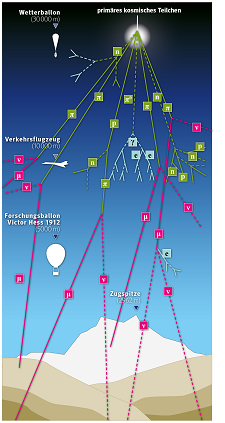URL: https://www.desy.de/school/school_lab/zeuthen_site/cosmic_particles/basics/introduction/index_eng.html
Breadcrumb Navigation
Introduction Cosmic Particles
Introduction Cosmic Particles
A continuous flux of primary cosmic particles bombards the earth, interacting with air atoms and producing a large number of new particles. We do not feel or see these particles although they are penetrating us. It is only possible to detect cosmic particles and to explore their properties with special equipment.
To understand the sources of cosmic particles it is important to be familiar with their energies. Measurements have shown a very broad energy spectrum. Protons and electrons produced at the sun's surface have rather low energies. But particles with extremely high energies, up to 14 million times higher than the protons being accelerated by the largest particle accelerator LHC (Large Hadron Collider) at CERN, have also been measured. One of the goals of experimental and theoretical astroparticle physics is to understand how such extremely high energies can be generated.
Historically, the term cosmic radiation was used first, which is actually inaccurate. The discovery of cosmic rays in 1912 only showed an increase of radiation with rising distance from Earth's surface. For many years the nature and the origin of this radiation remained unknown. Meanwhile, many discoveries and investigations resulted in a wide spectrum of knowledge of cosmic particles. Some were even honoured with the Noble Prize. But many essential questions are still unanswered. Only model assumptions exist about the sources and the acceleration mechanisms of cosmic particles with extremely high energies. These still have to be verified by measurements.





